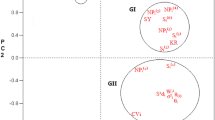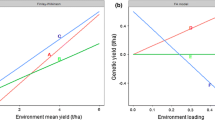Abstract
Partitioning of the genotypes by environment interaction (GEI) is important in order to determine the nature of the GEI. The objectives of this study were to assess the presence and nature of GEI for nine agronomic traits of rapeseed cultivars, and to identify cultivars with favorable levels of stable oil production. Nine rapeseed cultivars, including seven open pollinated and two hybrids, Hyola308 and Hyola401, were grown in ten environments under rain-fed warm areas of Iran. The GEI was significant for all traits and was partitioned into components representing heterogeneity due to environmental index and the remainder of the GEI. Among the all traits with a highly significant heterogeneity, the largest amount of heterogeneity removed from the GEI was for seeds per pod and seed weight. We found GEIs for both oil content and seed yield were largely influenced by differences in correlations among pairs of cultivars (86.8 and 71.4% of the GEI sum of squares, respectively), suggesting that crossover GEIs (i.e., change in genotype rankings among environments) are present. The mean correlation of each cultivar with all other cultivars (\( \bar{r}_{{ii^{\prime}}} \)) ranged from 0.53 to 0.83 for oil content and 0.86 to 0.96 for seed yield. A comparison was done of the significance of Sh-σ 2i (stability variance derived from total GEI) and Sh-S 2i (adjusted stability variance derived from residual GEI) assignable to each genotype for oil content and seed and oil yield. Based on Sh-σ 2i , three cultivars were unstable for oil content, whereas six cultivars were unstable for seed and oil yield. The removal of heterogeneity revealed that one unstable cultivar for oil content and three unstable cultivars for oil yield were judged to be stable. All cultivars with \( \bar{r}_{{ii^{\prime } }} \) ≤ 0.63 were labeled unstable for oil content, whereas all with \( \bar{r}_{{ii^{\prime } }} \) ≤ 0.94 were considered unstable for seed yield. The relationships between \( \bar{r}_{{ii^{\prime } }} \) and Sh-σ 2i were significant (P < 0.01) for oil content and seed yield. The results of rank correlation coefficients showed significant positive correlations of Yield-Stability statistic (YSi) with oil content and oil yield. Cultivars such as Option500 and Hyola401 were identified as having stable, high levels to seed yield and oil content.
Similar content being viewed by others
References
Baxevanos D, Goulas C, Tzortzios S, Mavromatis A (2008) Interrelationship among and repeatability of seven stability indices estimated from commercial cotton (Gossypium hirsutum L.) variety evaluation trials in three Mediterranean countries. Euphytica 161:371–382. doi:10.1007/s10681-007-9586-0
Bertoia LM, Burak R, Torrecillas M (2002) Identifying inbred lines capable of improving ear and Stover yield and quality of superior silage maize hybrids. Crop Sci 42:365–372
Brandle JE, Brûlé-Babel AL (1991) An integrated approach to oilseed rape cultivar selection using phenotypic stability. Theor Appl Genet 81:679–684. doi:10.1007/BF00226737
Butruille DV, Guries RP, Osborn TC (1999) Increasing yield of spring oilseed rape hybrids through introgression of winter germplasm. Crop Sci 39:1491–1496
Ceccarelli S (1989) Wide adaptation. How wide? Euphytica 40:197–205. doi:10.1007/BF00024512
Diepenbrock W (2000) Yield analysis of winter oilseed rape (Brassica napus L.): a review. Field Crops Res 67:35–49. doi:10.1016/S0378-4290(00)00082-4
Ebadi segherloo A, Sabaghpour SH, Dehghani H, Diepenbrock W, Kamrani M (2008) Non-parametric measures of phenotypic stability in chickpea genotypes (Cicer arietinum L.). Euphytica 162:221–229. doi:10.1007/s10681-007-9552-x
Eberhart SA, Russell WA (1966) Stability parameters for comparing varieties. Crop Sci 6:36–40
Emebiri LC, Matassa V, Moody DB (2005) Genstat programs for performing Muir’s alternative partitioning of genotype-by-environment interaction. J Heredity 96(1):78–79. doi:10.1093/jhered/esi003
Engqvist MG, Becker HC (1993) Correlation studies for agronomic characters in segregating families of spring oilseed rape (Brassica napus). Hereditas 118:211–216
Fan XM, Kang MS, Chen H, Zhang Y, Tan J, Xu C (2007) Yield stability of maize hybrid evaluated in multi-environment trials in Yunnan, China. Agron J 99:220–228. doi:10.2134/agronj2006.0144
GENSTAT (2008) GENSTAT 12th edn. VSN International Ltd (VSNi), http://www.vsni.co.uk
Gravois KA, Bernhardt JL (2000) Heritability and genotype × environment interactions for discolored rice kernels. Crop Sci 40:314–318
Gravois KA, Helms RS (1998) Seeding date effects on rough rice yield and head rice and selection for stability. Euphytica 102:151–159. doi:10.1023/A:1018344615296
Gunasekera CP, Martin LD, Siddique KHM, Walton GH (2006a) Genotype by environment interactions of Indian mustard (Brassica juncea L.) and canola (B. napus L.) in Mediterranean-type environments. I. Crop growth and seed yield. Eur J Agron 25:1–12. doi:10.1016/j.eja.2005.08.002
Gunasekera CP, Martin LD, Siddique KHM, Walton GH (2006b) Genotype by environment interactions of Indian mustard (Brassica juncea L.) and canola (B. napus L.) in Mediterranean-type environments. II. Oil and protein concentration in seed. Eur J Agron 25:13–21. doi:10.1016/j.eja.2006.02.001
Haynes KG, Wilson DR, Kang MS (1995) Genotype × environment interactions for specific gravity in diploid potatoes. Crop Sci 35:977–981
Kang MS (1988) A rank-sum method for selecting high-yielding, stable corn genotypes. Cereal Res Commun 16:113–115
Kang MS (1991) Modified rank-sum method for selecting high yielding, stable crop genotypes. Cereal Res Commun 19:361–364
Kang MS (1993) Simultaneous selection for yield and stability in crop performance trials: consequences for growers. Agron J 85:754–757
Kang MS, Gorman DP (1989) Genotype × environment interaction in maize. Agron J 81:662–664
Kang MS, Magari R (1995) STABLE: a basic program for calculating stability and yield-stability statistics. Agron J 87:276–277
Kang MS, Magari R (1996) New developments in selecting for phenotypic stability in crop breeding. In: Kang MS, Gauch HG Jr (eds) Genotype-by-environment interaction. CRC Press, Boca Raton, FL, pp 1–14
Kang MS, Miller JD (1984) Genotype × environment interactions for cane and sugar yield and their implications in sugarcane breeding. Crop Sci 24:435–440
Kang MS, Pham HN (1991) Simultaneous selection for high yielding and stable crop genotypes. Agron J 83:161–165
Kang MS, Miller JD, Darrah LL (1987) A note on relationship between stability variance and ecovalence. J Heredity 78:107
Kang MS, Gorman DP, Pham HN (1991) Application of a stability statistic to international maize yield trails. Theor Appl Genet 81:162–165. doi:10.1007/BF00215718
Krenzer EG, Thompson JD, Carver BF (1992) Partitioning of genotype × environment interactions of winter wheat forage yield. Crop Sci 32:1143–1147
Magari R, Kang MS (1993) Genotype selection via a new yield-stability statistic in maize yield trials. Euphytica 70:105–111. doi:10.1007/BF00029647
Moghaddam MJ, Pourdad SS (2009) Comparison of parametric and non-parametric methods for analyzing genotype × environment interactions in safflower (Carthamus tinctorius L.). J Agric Sci Camb 147:601–612. doi:10.1017/S0021859609990050
Mohammadi R, Amri A (2008) Comparison of parametric and non-parametric methods for selecting stable and adapted durum wheat genotypes in variable environments. Euphytica 159:419–432. doi:10.1007/s10681-007-9600-6
Moll RH, Cockerham CC, Stuber CW, Williams WP (1978) Selection responses, genetic-environmental interactions, and heterosis with recurrent selection for yield in maize. Crop Sci 18:641–645
Pazdernik DL, Hardman LL, Orf JH (1997) Agronomic performance and stability of soybean varieties grown in three maturity zones of Minnesota. J Prod Agric 10:425–430
Pham HN, Kang MS (1988) Interrelationships among and repeatability of several stability statistics estimated from international maize trials. Crop Sci 28:925–928
Qian W, Li Q, Noack J, Sass O, Meng J, Frauen M, Jung C (2009) Heterotic patterns in rapeseed (Brassica napus L.): II. Crosses between European winter and Chinese semi-winter lines. Plant Breeding. doi:10.1111/j.1439-0523.2008.01597.x
Rao MSS, Mullinix BG, Ranagappa M, Cebert E, Bhagsari AS, Sapra VT, Joshi JM, Dadson RB (2002) Genotype × environment interactions and yield stability of food-grade soybean genotypes. Agron J 94:72–80
Shafii B, Mahler KA, Price WJ, Auld DL (1992) Genotype × environment interaction effects on winter rapeseed yield and oil content. Crop Sci 32:922–927
Shukla GK (1972) Some statistical aspects of partitioning genotype-environmental components of variability. Heredity 29:237–245
Si P, Walton GH (2004) Determinants of oil concentration and seed yield in canola and Indian mustard in the lower rainfall areas of Western Australia. Aust J Agric Res 55:367–377
Si P, Mailer JM, Galwey N, Turner DW (2003) Influence of genotype and environment on oil and protein concentrations of canola (Brassica napus L.) grown across southern Australia. Aust J Agric Res 54:397–407. doi:10.1071/AR031510004-9409/04/030367
Smith AB, Cullis BR, Thompson R (2005) The analysis of crop cultivar breeding and evaluation trials: an overview of current mixed model approaches. J Agric Sci Camb 143:449–462
Sneller CH, Kilgore-Norquest L, Dombek D (1997) Repeatability of yield stability statistics in soybean. Crop Sci 37:383–390
Truberg B, Hühn M (2000) Contributions to the analysis of genotype × environment interactions: comparison of different parametric and non-parametric tests for interactions with emphasis on crossover interactions. J Agron Crop Sci 185:267–274. doi:10.1046/j.1439-037X.2002.00549.x
Upadhya MD, Cabello R (2000) Selection of parental lines using stability analysis of hybrid true potato seed families produced through line × tester method. CIP program report 1999–2000. CIP, Lima, Peru, pp 197–206
Virk DS, Mangat BK (1991) Detection of cross over genotype × environment interactions in pearl millet. Euphytica 52:193–199. doi:10.1007/BF00029396
Waldron BL, Asay KH, Jensed KB (2002) Stability and yield of cool-season pasture grass species grown at five irrigation levels. Crop Sci 42:890–896
Wricke G (1962) Über eine Methode Zur Erfassung der ökologischen Streubreite in Feldversuchen. Zeitschrift für Pflanzenzüchtung 47:92–96
Author information
Authors and Affiliations
Corresponding author
Rights and permissions
About this article
Cite this article
Moghaddam, M.J., Pourdad, S.S. Genotype × environment interactions and simultaneous selection for high oil yield and stability in rainfed warm areas rapeseed (Brassica napus L.) from Iran. Euphytica 180, 321–335 (2011). https://doi.org/10.1007/s10681-011-0371-8
Received:
Accepted:
Published:
Issue Date:
DOI: https://doi.org/10.1007/s10681-011-0371-8




